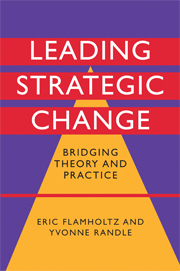Book contents
- Frontmatter
- Contents
- List of exhibits
- Preface
- Acknowledgments
- Part I An integrative framework for leading strategic and organizational change
- Part II Leading strategic change in actual organizations
- Part III Leading strategic change: lessons learned from practice
- 13 Lessons and insights from case studies of change
- Appendix: References for further reading on leading change
- Index
13 - Lessons and insights from case studies of change
from Part III - Leading strategic change: lessons learned from practice
Published online by Cambridge University Press: 22 September 2009
- Frontmatter
- Contents
- List of exhibits
- Preface
- Acknowledgments
- Part I An integrative framework for leading strategic and organizational change
- Part II Leading strategic change in actual organizations
- Part III Leading strategic change: lessons learned from practice
- 13 Lessons and insights from case studies of change
- Appendix: References for further reading on leading change
- Index
Summary
Introduction
In Part II we examined nine case studies of strategic change using a “stand-alone” or “vertical” analysis. In this chapter we look at the cases studies as a set and undertake a “horizontal” analysis across the different cases.
In order to derive these insights, we look at the cases from a number of different perspectives. A primary purpose of this chapter, then, is to identify specific lessons about change and change management that can be gleaned from this sample of nine companies.
We conclude this chapter with some thoughts for researchers and scholars about “taking forward the integrative framework” that was proposed in Part I.
Some lessons about the nature of change
In this section, we look at the nature of the change process in terms of what we have learned from the case studies. We examine the different but related aspects of the cases, including the catalyst for change, the overall purpose or objective of the change process, the type of change (including the focus and magnitude of change), and the duration of change. We also identify and examine aspects of the barriers to change that have been encountered.
The catalyst for or driver of change
A catalyst for or driver of change is the trigger, in a sense, for the change process. There appear to be three different catalysts for change in our sample: (1) problems created by organizational growth; (2) the recognition of a “new” market or market opportunity; and (3) environmental changes (including increased competition, changes in customers and customer needs, the “globalization” of markets, among others).
Information
- Type
- Chapter
- Information
- Leading Strategic ChangeBridging Theory and Practice, pp. 229 - 252Publisher: Cambridge University PressPrint publication year: 2008
